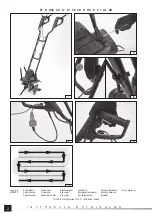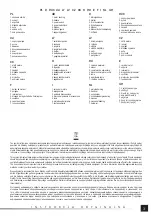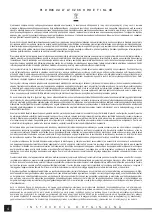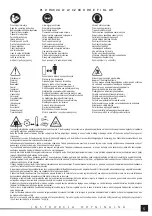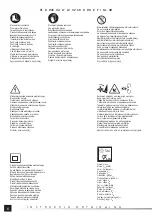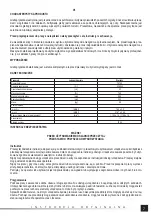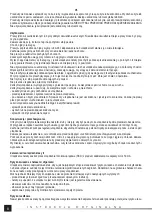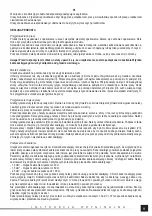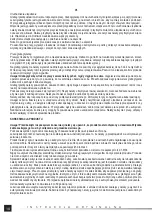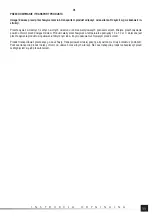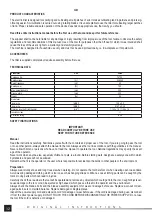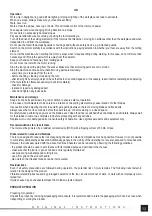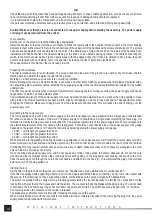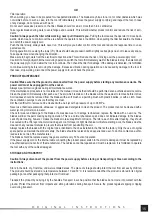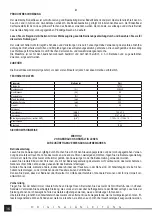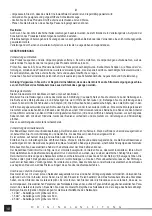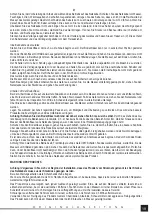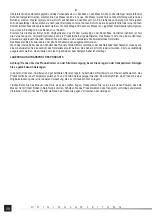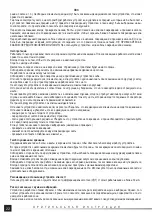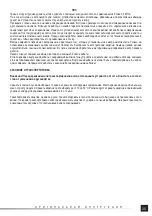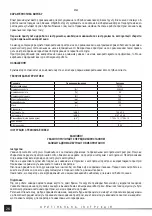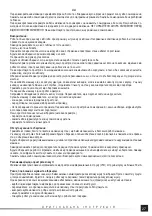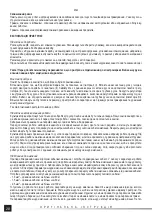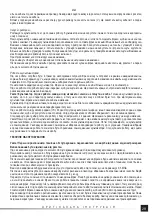
15
O R I G I N A L I N S T R U C T I O N S
GB
Tiller operation
When working, you have to be prepared for unexpected situations. The blades may hit a stone, root or other obstacle which was
not visible before. In such a case, turn the tool o
ff
immediately, remove the power supply cord plug and inspect the tool. In case
of any damage, do not proceed with work.
Do not exert excessive pressure on the tiller. Blades should not sink in more than 3 to 4 centimetres.
Take regular breaks during work to avoid fatigue and overwork. This will allow better product control and reduce the risk of acci-
dents.
Caution! Always push the tiller while working; never pull it towards you.
Pulling the tool causes the operator to move back-
wards, which means no control over the area behind the operator’s back. In addition, when pulling the tiller backwards, the blades
can catch the power supply cord.
Push the tiller slowly; always walk, never run. This will give you better control of the tool and reduce the response time to unex-
pected events.
During operation, move along the rows (VII). Rows should be kept equal in width, slightly overlapping so as not to leave any space.
Take special care when changing the direction.
Make sure to begin work from the electrical connection side. This will reduce the risk of driving over the power supply cord.
Caution! If a foreign object hits the tool during operation, switch the tool o
ff
immediately, wait for the blades to stop, then disconnect
the power supply cord, and allow the tool to cool down. Then check the tiller for damage. If the damage is detected, it is forbidden
to continue working before removing the damage. Excessive vibration during operation can be caused by damage to the tool. In
that case, stop working, disconnect the power supply cord, and check the product.
PRODUCT MAINTENANCE
Caution! Make sure that the product is disconnected from the power supply before starting any maintenance works. The
power cord must be unplugged from the socket.
Always wear protective gloves during all maintenance works.
If the maintenance procedure is not contained in the manual, it means that it should be performed at an authorised service centre.
Clean the product immediately after each use. The soil which remains on the blades will be the easiest to remove before it dries.
Soil residues should be removed from the blades with a soft brush or a painting brush with plastic bristles, or with a cloth. Clean
the ventilation openings to ensure that they are clear.
Dirt that is di
ffi
cult to remove can be cleaned with an air jet with a pressure of up to 0.3 MPa.
Never use chemicals, alkaloids, abrasives, or aggressive detergents to clean the product. The product cannot be cleaned with a
water jet or by immersion in water.
Check for wear and damage to the blades. If excessive wear or damage is observed, replace the blade with a new one. The
blades will lose the paint coating during operation. This is a normal phenomenon and does not indicate damage to the blades.
Lack of paint coating, however, makes the blades more susceptible to corrosion. Therefore, each time after cleaning, they should
be covered with a thin layer of anti-corrosion agent or a thin layer of light mechanical oil. Before starting work, the blades must be
cleaned of any residual material to prevent the material from penetrating the soil.
Always replace the blades with the original ones, identical to the ones installed in the tiller at the factory. Only the use of original
spare parts can maintain the product safety. The blade should be replaced by an experienced user. To do this, contact an author-
ised service centre of the manufacturer.
The blades should be replaced every two years or after every 50 hours of operation.
If the power supply cord or the internal cable connecting the product power switch to the motor is damaged, it must be replaced by
an authorised service centre of the manufacturer. The cables cannot be repaired and must be replaced. It is forbidden to operate
the tool with any of the cables damaged.
STORAGE AND TRANSPORT
Caution! Always disconnect the product from the power supply before storing or transporting it. Clean according to the
instructions.
Store in the dark, dry, frost-free, and well-ventilated areas. The place of storage should protect the tool from access by children.
The product should be stored at a temperature between 10 and 30°C. It is recommended that the product is stored in its original
packaging or another packaging that protects it from dust.
Transport the product by carrying it by the handles. Transport in such a position that the blades do not come into contact with the
ground. Protect the product from impacts and strong vibrations during transport. Secure the product against slipping or tipping
over during transport.
Summary of Contents for 79725
Page 22: ...22 RUS II 30...
Page 23: ...23 RUS I II III III VII...
Page 24: ...24 RUS 1 0 2 40 1 5 2 60 2 5 2 100 V 3 4 VII...
Page 25: ...25 RUS 0 3 50 10 30...
Page 27: ...27 UA II 30...
Page 28: ...28 UA I II III III VII 1 0 2 40 1 5 2 60 2 5 2 100...
Page 29: ...29 UA V 3 4 VII 0 3...
Page 30: ...30 UA 50 10 30 C...
Page 78: ...78 GR RCD 30 mA...
Page 79: ...79 GR I II III III VII 1 0 mm2 40 m 1 5 mm2 60 m...
Page 80: ...80 GR 2 5 mm2 100 m V 3 4 VII 0 3 Mpa...
Page 81: ...81 GR 50 10 30 C...


